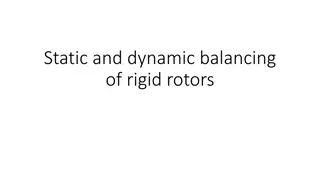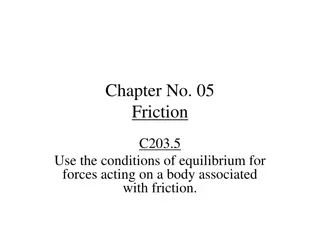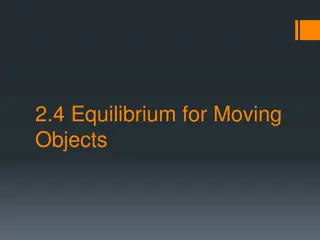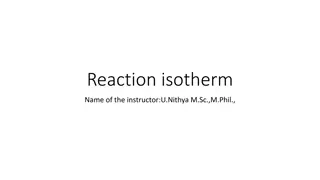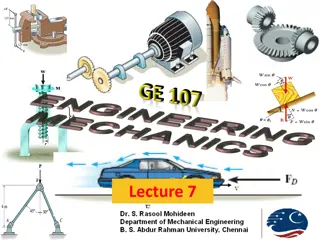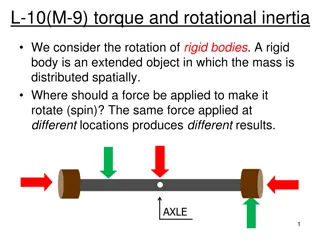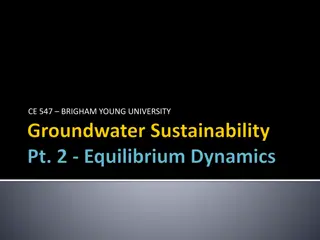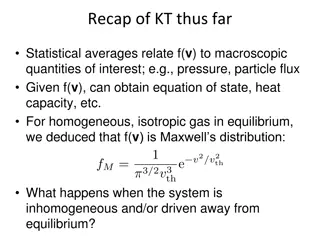Understanding Equilibrium in Rigid Bodies
Explore the concept of equilibrium in rigid bodies through problem-solving scenarios involving forces, moments, and tensions. Learn how to ensure balance and stability in resting bodies by analyzing forces and moments. Diagrams and step-by-step calculations help in understanding the physics behind equilibrium in rigid bodies in various positions.
Download Presentation

Please find below an Image/Link to download the presentation.
The content on the website is provided AS IS for your information and personal use only. It may not be sold, licensed, or shared on other websites without obtaining consent from the author. Download presentation by click this link. If you encounter any issues during the download, it is possible that the publisher has removed the file from their server.
E N D
Presentation Transcript
Statics of rigid bodies You need to be able to solve problems about rigid bodies that are resting in equilibrium If a body is resting in equilibrium: There is no resultant force in any direction, so the horizontal and vertical forces sum to 0 The sum of moments about any point is 0 (the point does not have to be on the body itself) 5B
Statics of rigid bodies D You need to be able to solve problems about rigid bodies that are resting in equilibrium TCos40 T (2) V 40 TSin40 40 A B 3m H C 1m 2m A uniform rod AB, of mass 6kg and length 4m, is smoothly hinged at A. A light inextensible string is attached to the rod at a point C where AC = 3m, and the point D, which is vertically above point A. If the string is keeping the rod in equilibrium in a horizontal position and the angle between the string and the rod is 40 , calculate: (1) 6g Start with a diagram and label on all the forces split the tension into horizontal and vertical components At the hinge there will be a vertical reaction and a horizontal reaction Take moments about point A (as we have 3 unknown forces, 2 will be eliminated by doing this!) (1) 6? 2 = 12? ?? ????????? (2) ????40 3 = 3????40 ?? ????????????? a) The tension in the string ? = 61? These must be equal as the rod is in equilibrium 3????40 = 12? b) The magnitude and direction of the reaction at the hinge. Divide by 3Sin40 12? 3???40 ? = Calculate ? = 61? 5B
Statics of rigid bodies D You need to be able to solve problems about rigid bodies that are resting in equilibrium 61Cos40 61 V 40 61Sin40 40 A B 3m H C 1m A uniform rod AB, of mass 6kg and length 4m, is smoothly hinged at A. A light inextensible string is attached to the rod at a point C where AC = 3m, and the point D, which is vertically above point A. If the string is keeping the rod in equilibrium in a horizontal position and the angle between the string and the rod is 40 , calculate: 6g Resolve Horizontally (set left and right forces equal to each other) ? = 61???40 Calculate ? = 46.72? Resolve Vertically (set upwards and downwards forces equal to each other) a) The tension in the string ? = 61? ? + 61???40 = 6? Subtract 61Sin40 b) The magnitude and direction of the reaction at the hinge. ? = 6? 61???40 Calculate ? = 46.72? ? = 19.6? ? = 19.6? 5B
Statics of rigid bodies D You need to be able to solve problems about rigid bodies that are resting in equilibrium 61Cos40 61 V 40 61Sin40 40 A B 3m H C 1m A uniform rod AB, of mass 6kg and length 4m, is smoothly hinged at A. A light inextensible string is attached to the rod at a point C where AC = 3m, and the point D, which is vertically above point A. If the string is keeping the rod in equilibrium in a horizontal position and the angle between the string and the rod is 40 , calculate: 6g R R V V 19.6 A A a) The tension in the string ? = 61? H 46.72 H The resultant force will be somewhere between V and H Use a right-angled triangle to help b) The magnitude and direction of the reaction at the hinge. 46.722+ 19.62 ????????? = ? = 46.72? ? = 19.6? Calculate ????????? = 50.6? ????????? = 50.6? 5B
Statics of rigid bodies D You need to be able to solve problems about rigid bodies that are resting in equilibrium 61Cos40 61 V 40 61Sin40 40 A B 3m H C 1m A uniform rod AB, of mass 6kg and length 4m, is smoothly hinged at A. A light inextensible string is attached to the rod at a point C where AC = 3m, and the point D, which is vertically above point A. If the string is keeping the rod in equilibrium in a horizontal position and the angle between the string and the rod is 40 , calculate: 6g R R V V 19.6 A A a) The tension in the string ? = 61? H 46.72 H You also need to calculate the angle above the horizontal b) The magnitude and direction of the reaction at the hinge. 19.6 46.72 ????? = ??? 1 ? = 46.72? ? = 19.6? Calculate ????????? = 50.6? ,22.8 ????? ? ? ????????? ????? = 22.8 5B




